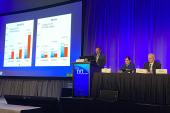Reinterventions Rare Yet Predictable After TAVI, French Registries Show
Procedural planning and attention to detail can help, but heart teams should be realistic about what lies ahead, experts say.

Fewer than one in 50 TAVI patients undergo reintervention within 8 years, with most of the repeat procedures done early and using redo TAVI, according to French registry data spanning from 2010 to 2022. While that’s reassuring, there is still a need for continued, long-term study among low-risk and younger patients with longer life expectancy, researchers say.
The results, from the FRANCE 2 and FRANCE TAVI registries, were published online recently ahead of print in the March 11, 2025, issue of the Journal of the American College of Cardiology.
“For us, the incidence [of reintervention] is low, which is clearly a good message,” said lead investigator Eric Durand, MD, PhD (CHU Rouen, France). Also informative, he noted to TCTMD, is their finding that most individuals who underwent repeat treatment did so within 1 year, indicating that in these cases “the results of the index TAVR were not very good and necessitated an intervention very soon.”
It’s important to keep in mind, though, that the population they studied tended to be older, with a shorter life expectancy, so the results may not capture the true incidence in today’s patients, he added. The study also didn’t track patients who could not undergo reintervention because they were too sick or had other barriers.
Gilbert H.L. Tang, MD (Mount Sinai Health System, New York, NY), who co-authored an accompanying editorial, told TCTMD that the study adds to the growing body of literature on reintervention after TAVI.
“All bioprosthetic valves eventually fail,” whether those devices are transcatheter or surgical, he commented. With guidelines now endorsing TAVI down to a threshold of 65 years in the United States and 75 years in Europe, it’s necessary to keep a close eye on how the bioprostheses hold up—and how subsequent treatments fare—over not just years but potentially decades, he added.
For us, the incidence [of reintervention] is low, which is clearly a good message. Eric Durand
While some patients have anatomy that necessitates the transcatheter valve be surgically removed, which is a higher-risk procedure, others are eligible for a valve-in-valve reintervention, Tang noted. “Redo TAVR, I think, so far has been pretty safe in select patients, but the community needs to figure out how to do this reproducibly, because if you look at the number of cases per site, it’s pretty low. You don’t see these too often, unless you’re a high-volume center.”
A minimalist approach to TAVI has gained traction in recent years, but Tang said he doesn’t want the pendulum to swing too far. “I think the mindset has to shift now,” he urged. “You want to do as good a job as you can at the index procedure. Why? Because we know that if we don’t do a good job, these valves will fail early and you’ll have the problem of having to fix it again, and no patient would want that.”
FRANCE 2 and FRANCE TAVI Registries
After excluding TAVI patients who needed reintervention due to infective endocarditis, Durand along with senior author Nicolas Dumonteil, MD (Clinique Pasteur, Toulouse, France), and colleagues analyzed 72,850 patients in the combined FRANCE 2 and FRANCE TAVI dataset.
By 8 years, when accounting for all-cause death as a competing risk, the cumulative incidence of reintervention was 1.7%. A total of 591 patients (0.81%) underwent redo TAVI and 111 (0.15%) required explant TAVI. The median time to redo TAVI was 0.33 years; for explant TAVI, it was 0.64 years. Most reinterventions (62.1%) occurred early, within 1 year.
Patients who had a reintervention tended to be younger and more often had chronic renal failure requiring dialysis and a history of CABG. They also had a higher aortic valve area and higher prevalence of aortic regurgitation ≥ grade 2 before the index procedure.
Reintervention was more frequent when the index approach wasn’t transfemoral and when using first- and second-generation versus third-generation transcatheter heart valves but was less frequent when using a balloon-expandable versus self-expanding device.
Repeat procedures were more common when the index TAVI occurred after 2017 versus before (1.1% vs 1.9%; P < 0.0001). Additionally, postprocedural factors mattered: reinterventions were more common among patients whose mean aortic gradient was > 20 mm Hg and those whose paravalvular aortic regurgitation was ≥ grade 2 immediately after the index TAVI.
Independent predictors of reintervention included age and mean aortic gradient before TAVI as well as mean gradient > 20 mm Hg, aortic regurgitation ≥ grade 2, and PCI after TAVI.
All bioprosthetic valves eventually fail. Gilbert Tang
Mean follow-up duration was 989.1 days. On Kaplan-Meier analysis, 6-year mortality was high but similar between patients who had early versus late reintervention (76.2% vs 64.0%; P = 0.77). Mortality was higher at 6 years among those who underwent explant versus redo TAVI.
Given this discrepant mortality, heart teams deciding how best to proceed in patients with a long life expectancy should, at the time of the index procedure, consider “factors associated with a risk of mismatch or significant residual paravalvular regurgitation, and factors precluding the option of redo TAVR” that might influence the risk/benefit balance, the authors advise. In these scenarios, SAVR might be preferred to TAVI.
Age Not the Only Factor
The editorial, by Tang along with Syed Zaid, MD (Baylor College of Medicine and Michael E. DeBakey VA Medical Center, Houston, TX), and Ole De Backer, MD, PhD (University of Copenhagen, Denmark), also emphasizes the need to think ahead.
“Mitigating reintervention risk requires a proactive approach, beginning with optimal procedural planning and valve selection at the index procedure,” they write, suggesting that tools like the Minneapolis Heart Institute Foundation’s Redo-TAV app as well as the Heart Valve Collaboratory framework could enable this process.
Tang pointed out that younger age is, of course, one indicator that a patient might outlive their first valve, though not the only factor. “We need to set the expectations upfront” based on not only longevity and anatomy but also comorbid conditions, he said. “This is especially important, because I think what we’ve seen is there are a lot of patients out there with not just isolated aortic stenosis. They have CAD, they have other valve disease, they also have A-fib.”
In those situations, especially in younger patients, SAVR may be “a more attractive option” from the get-go, said Tang. “It’s a heart team discussion, but I think the patients and the cardiologists need to be aware that, yeah, you’re referring the patient for aortic stenosis, but there are other things that we can consider.”
Innovations in the field also will help to reduce the need for reintervention, Tang predicted.
For instance, novel pharmacotherapies could be protective against bioprosthetic valve failure. New device technologies are being explored, as well, with ongoing research into polymeric heart valves that might match the durability of mechanical valves without the need for lifelong anticoagulation. “The other pathway that people are pursuing is tissue technology, but mounted on the device in such a way that it will optimize the opening and closing [of the valve] and the function,” he noted.
Durand said that, at his center, the next step involves prospectively tracking echocardiographic and clinical factors among TAVI patients on an annual basis after their index procedure. “I think it is very, very important, first, to evaluate more accurately the real incidence of bioprosthetic valve dysfunction and, second, to identify clearly what are the main causes of dysfunction,” he said, pointing out that in their study, they did not know the precise reasons for reintervention.
“And, third, we have to get data regarding late reintervention in younger patients,” Durand stressed. Such patients, by virtue of their longer lifespans, will likely need a second procedure.
Caitlin E. Cox is News Editor of TCTMD and Associate Director, Editorial Content at the Cardiovascular Research Foundation. She produces the…
Read Full BioSources
Durand E, Eltchaninoff H, Tchetche D, et al. Predictors of outcomes of reintervention after transcatheter aortic valve replacement: FRANCE 2 and FRANCE TAVI registries. JACC. 2025;85:896-907.
Tang GHL, Zaid S, De Backer O. Navigating the landscape of reinterventions after TAVR. JACC. 2025;85:908-911.
Disclosures
- Durand has received a grant by the French Government, managed by the National Research Agency (ANR) under the program “Investissements d’avenir” and is supported by a grant from the GCS G4 as part of the FHU-CARNAVAL, labeled AVIESAN; and has received lecture fees from Edwards Lifesciences.
- Tang has received speaker’s honoraria and served as a physician proctor, consultant, advisory board member, TAVR publications committee member, RESTORE study steering committee member, APOLLO trial screening committee member, and IMPACT MR steering committee member for Medtronic; has received speaker’s honoraria and served as a physician proctor, consultant, advisory board member and TRILUMINATE trial anatomic eligibility and publications committee member for Abbott Structural Heart; has served as an advisory board member for Boston Scientific; as a consultant and physician screening committee member for Shockwave Medical; as a consultant for Philips, Edwards Lifesciences, Peija Medical, and Shenqi Medical Technology; and has received speaker’s honoraria from Siemens Healthineers.
- De Backer has received institutional research grants and consulting fees from Abbott, Boston Scientific, and Medtronic.
- Zaid has reported that he has no relationships relevant to the contents of this paper to disclose.





Comments